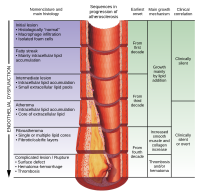
Photo from wikipedia
Background Acute ischemic stroke (AIS) with intracranial large vessel occlusion (LVO) is refractory to reperfusion because of the underlying intracranial atherosclerosis (ICAS), and this condition often requires salvage methods such… Click to show full abstract
Background Acute ischemic stroke (AIS) with intracranial large vessel occlusion (LVO) is refractory to reperfusion because of the underlying intracranial atherosclerosis (ICAS), and this condition often requires salvage methods such as balloon angioplasty and rescue stenting (RS). In this study, we investigated the short-term outcomes of RS after failed mechanical thrombectomy (MT) for the treatment of acute intracranial atherosclerotic occlusion. Methods We retrospectively evaluated the clinical data of 127 patients who underwent MT for acute intracranial atherosclerotic occlusion in our hospital between August 2018 and January 2022. The degree of recanalization was evaluated immediately after the treatment by Modified Thrombolysis in Cerebral Infarction (mTICI). The modified Rankin Scale (mRS) was used 90 days after treatment to evaluate the neurological functions. In addition, the incidence of symptomatic intracranial hemorrhage (sICH) and postoperative mortality within 90 days of treatment were calculated. Results Among the 127 patients, 86 patients (67.7%) had revascularization (mTICI 2b-3) immediately after MT (non-RS group), and RS was performed in 41 patients (32.3%) after MT failure (RS group). No difference in the sICH rate was observed between the two groups (17.1 vs. 16.3%, p = 0.91). There was a slightly higher mortality rate in the RS group (14.6 vs. 12.8%, p = 0.71); however, the difference was not significant. There was no difference in the proportion of patients in the RS and non-RS groups who had a 90-day mRS score of 0–2 (48.8 vs. 52.3%, p = 0.76). Conclusions Rescue stenting after MT failure might be a feasible rescue modality for treating acute intracranial atherosclerotic occlusion.
Journal Title: Frontiers in Neurology
Year Published: 2023
Link to full text (if available)
Share on Social Media: Sign Up to like & get
recommendations!